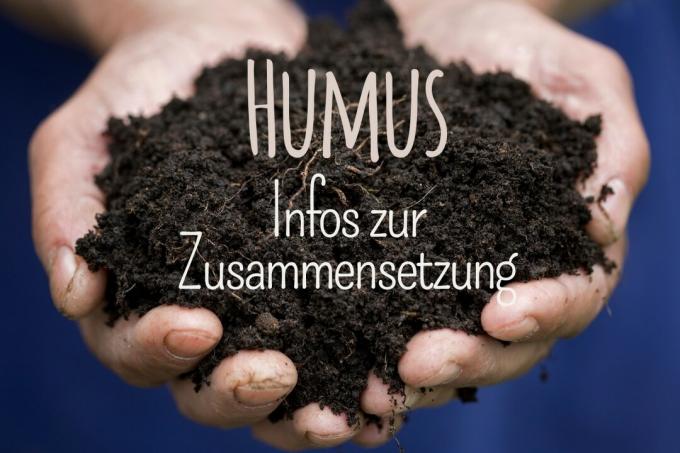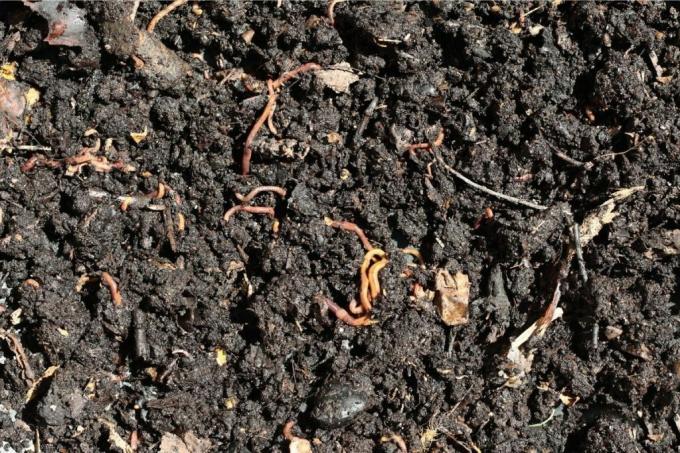
table of contents
- definition
- Humus formation
- Different types of humus
- Determine the humus content
- frequently asked Questions
Humus is important for plants, but few know exactly what it is and what parts humus soil consists of. However, every hobby gardener can contribute a lot to building up humus.
In a nutshell
- Humus is a mixture of organic materials
- the humus formation takes place in several stages
- Different animals such as earthworms are required for humus formation
- The aim is the formation of permanent humus
definition
The terms humus and compost are often used incorrectly, but compost is only one aspect of humus formation. Humus is part of the soil in the area of the topsoil. It consists largely of organic materials that have died.
The following organic materials can be found in humus:
- leaves
- root
- Feces
- dead insects
- dead animals
- dead mushrooms
- dead bacteria

Humus formation
The formation of humus is also called Humification. The implementation of the organic materials is divided into four phases. During humification, both chemical processes and animal support are necessary, which are responsible for the decomposition of the material.
-
Phase 1: The chlorophyll in the leaves is broken down while cells remain intact. However, this phase is only necessary for leaves and begins to turn autumn on the tree.
-
Phase 2: The initial phase is the first step in the actual decomposition. Here, water-soluble components such as sugar compounds or amino acids are washed out. During this phase, numerous microorganisms also settle in the area of the organic material, because they feed on the grown substances. In years that are very dry, leaching takes longer, which also slows down humus formation.
-
Phase 3: Now different animal helpers are used. They break up the organic matter and only constituents that are difficult to break down remain. The following animals are responsible for the shredding of the organic material:
- worms
- Millipede
- various arachnids
- Mites
- Nematodes
- Phase 4: Finally, the last remaining components are broken down by fungi. Various inorganic components are also released during this phase. This includes, for example, CO2 or various minerals.
Tip: Above all, you can accelerate the shredding phase in the garden by shredding organic material such as leaves once.
Different types of humus
Humus soil differs in its composition. Basically there are two types of humus:
- Nutritional humus
- Permanent humus

The aim of humus formation, especially with natural gardeners, is the conversion of nutrient humus into permanent humus.
Permanent humus has many advantages, because it contains a lot of bound soil nitrogen, which is available for plants. Permanent humus occurs when humic substances are further broken down in the nutrient humus. Another form of targeted permanent humus production is composting. However, it is only in the final stage of composting that one speaks of permanent humus.
Note: Due to the high content of bound nitrogen in ripe compost, you can use it as fertilizer. Plants should never be planted in pure compost, as this can lead to overfertilization and high nitrogen content in the vegetables.
Determine the humus content
With the so-called mud sample, you can roughly estimate for yourself which parts your soil consists of and how much humus or humus. Starting materials for the formation is approximately present.
- Fill 1.5l water bottle with soil samples from different places
- divide up earth with a spade
- of which approx. Take a 2cm wide piece
- Fill the wrong one with water
- Shake vigorously for a few minutes
- Put down the bottle and let it sit for approx. Wait 5 minutes
- different components settle out
- The composition can be roughly identified
- bottom layer: small stones and sand
- 2 layer: clay
- above it, clay floats in the murky water
- top layer: humus layer
- the thicker, the more nutrients available in the soil
frequently asked Questions
Humus soil has many positive properties. This includes not only the bound nitrogen, but also its fine-crumbly structure, which makes it easier for the roots to anchor themselves. Humus soil can also store a lot of water, which in turn is available to the plants.
There is no general answer to this question. Soils rich in nutrients offer less biodiversity, but vegetables provide a good basis for growth. On the other hand, a nitrogen content that is too high is not good either, because many vegetables can store the nitrogen.
No, so-called area composting is simpler, in which weeds are simply composted on the spot. Mulching also contributes to the increase in the humus layer.
